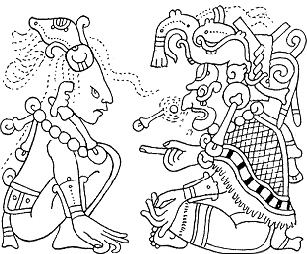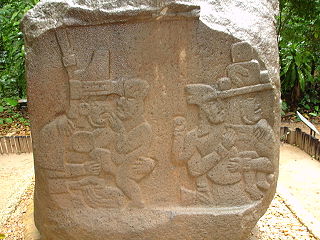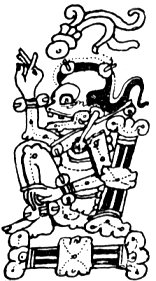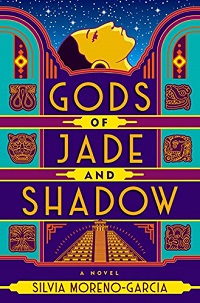Summary
The story is set in the late 1920s as Mexico emerges from its revolutionary era into the Jazz Age. After her father dies, Casiopea Tun and her mother move back to their native Mayan town of Uukumil in the Yucatán, where she grows up as an unwanted poor relation in her wealthy grandfather's house. She is especially tormented by her spoiled, bitter cousin Martín Leyva. At eighteen, Casiopea works as a servant for her grandfather, dreaming of escape.
In a forbidden chest in her grandfather's bedroom, she discovers the bones of the Mayan death god Hun-Kamé. A shard of bone pierces her thumb, restoring Hun-Kamé to a semblance of life. Bound to Casiopea, the god enlists her in his quest to regain his missing body parts, which his twin brother and rival Vucub-Kamé has scattered throughout Mexico and left in the keeping of sorcerers, demons, and other supernatural entities. Once he is whole, he hopes to retake rulership of Xibalba, the Mayan underworld, from which he has been deposed by his brother.
Their journey takes them throughout Mexico, from Yucatán to Veracruz, Mexico City, El Paso, and Baja California. Their parasitic relationship powers their quest, as Casiopea sacrifices more and more of her vitality to Hun-Kamé, and he in turn takes on more and more of the attributes of mortality. As Hun-Kamé becomes increasingly mortal, he and Casiopea start to fall in love with each other, even though both of them know they cannot be together. Throughout their journey, they must deal with the machinations of the god's brother and his inhuman and human allies, particularly Casiopea's cousin Martín, who serves Vucub-Kamé much as she does Hun-Kamé.
The root of the gods’ rivalry lies in Vucub-Kamé's lust to restore the bloody sacrifices and glories of Mayan and Aztec times, which Hun-Kamé is content to leave in the past. Their rivalry ends with both their mortal proxies consigned to Xibalba for a deceptively simple contest: walking the Black Road to the Jade Palace, with the lives of the twin death gods and the fate of the world as the stakes. The one who reaches the palace first wins, but to stray from the road means suffering k’up kaal, the ritual beheading to slake the blood-thirst of the underworld pantheon.
Initially struggling, Casiopea faces the many tricks and enemies that lie upon the Black Road. Once she evades Kamazotz, a giant bat, she gains some confidence and begins to catch up to Martín. However, Martín reaches the foot of the Jade Palace before she even reaches the outskirts of the Black City. Casiopea realizes that there is no way to win the contest, so she declares her allegiance to Hun-Kamé and slits her throat. Her sacrifice is acknowledged as a victory by both Hun-Kamé and Vucub-Kamé. Now the rightful ruler of Xibalba, Hun-Kamé restores Casiopea to life and, inspired by Casiopea's selflessness, forgives his brother instead of punishing him. Casiopea and Martín are returned to the mortal realm, where Martín decides to prolong his absence from Uukumil. Now alone and unsure of her future, Casiopea reunites with Loray, a demon who aided her and Hun-Kamé earlier in their journey. Together they embark on a new adventure with Casiopea fulfilling her long-time dream of learning to drive.
Reception
In a starred review, Publishers Weekly states the author "crafts a magical novel of duality, tradition, and change ... Moreno-Garcia's seamless blend of mythology and history provides a ripe setting for Casiopea's stellar journey of self-discovery, which culminates in a dramatic denouement. Readers will gladly immerse themselves in [the author's] rich and complex tale of desperate hopes and complicated relationships." [2] [3]
Shelley M. Diaz in Library Journal calls the book "a stirring historical fantasy set in the Roaring Twenties and steeped in Mayan mythology. ... Lavish clothes; jazzy music; and ruminations on life, death, fate, and the cosmos combine with blood-drenched nightmares, grisly religious rituals, and road-trip high jinks. An author's note and glossary of Spanish and Nahuatl terms further explores the source material. Snappy dialog, stellar worldbuilding, lyrical prose, and a slow-burn romance make this a standout." She likens its appeal to the works of Naomi Novik, Nnedi Okorafor, and N. K. Jemisin. [4] [5]
Noting that "[m]ore and more fantasy is drawing on mythologies from around the world," Eric Brown observes in The Guardian that "Silvia Moreno-Garcia brings Mayan myths to 1920s Mexico," and "[t]here follows a richly picaresque adventure as Casiopea and Hun-Kamé travel around Mexico on the god's quest. This is a moving description of a young girl's coming of age and a seamless fusion of the real and the magical." [6]
Electra Pritchett in Strange Horizons writes "Gods of Jade and Shadow is not a fairy tale, though it unfolds like one, and it wears the trappings of that paradigm as a god might wear a cloak of feathers. But ... Gods of Jade and Shadow is a hero tale, and Casiopea herself is the protagonist. ... Casiopea does not choose to save herself; she makes the hero's choice, and chooses to save others." She notes that "[a]s fantasy has finally become more inclusive and less Eurocentric over the past decade or so ... it has become possible to imagine books like this one as something more than lapidary one-offs. It may be too much to talk about Gods of Jade and Shadow and, say, Aliette de Bodard's Servant of the Underworld trilogy as trailblazers of Mesoamerican fantasy, but they are certainly part of a larger upwelling of indigenous American themes and settings in the genre—Rebecca Roanhorse's Sixth World series being another recent, excellent example. Although pre-Columbian mythology and magic and the Roaring Twenties may seem like a strange combination, in Moreno-Garcia's hands they comprise an enchanting cocktail, just as Casiopea's unsentimental view on her story is the perfect counterpart to its fantastic and at times hair-raising events. Raise a glass, and keep more like this coming." [7]

Mayan or Maya mythology is part of Mesoamerican mythology and comprises all of the Maya tales in which personified forces of nature, deities, and the heroes interacting with these play the main roles. The myths of the era have to be reconstructed from iconography. Other parts of Mayan oral tradition are not considered here.

Xibalba, roughly translated as "place of fright", is the name of the underworld in Maya mythology, ruled by the Maya death gods and their helpers. In 16th-century Verapaz, the entrance to Xibalba was traditionally held to be a cave in the vicinity of Cobán, Guatemala. Cave systems in nearby Belize have also been referred to as the entrance to Xibalba. In some Maya areas, the Milky Way is viewed as the road to Xibalba.

In the Late Post-Classic Maya mythology of the Popol Vuh, Camazotz is a bat spirit at the service of the lords of the underworld. Camazotz means "death bat" in the Kʼicheʼ language. In Mesoamerica generally, the bat is often associated with night, death, and sacrifice.

Popol Vuh is a text recounting the mythology and history of the Kʼicheʼ people of Guatemala, one of the Maya peoples who also inhabit the Mexican states of Chiapas, Campeche, Yucatan and Quintana Roo, as well as areas of Belize, Honduras and El Salvador.

The Maya Hero Twins are the central figures of a narrative included within the colonial Kʼicheʼ document called Popol Vuh, and constituting the oldest Maya myth to have been preserved in its entirety. Called Hunahpu[hunaxˈpu] and Xbalanque[ʃɓalaŋˈke] in the Kʼicheʼ language, the Twins have also been identified in the art of the Classic Mayas. The twins are often portrayed as complementary forces.
Xquic is a mythological figure known from the 16th century Kʼicheʼ manuscript Popol Vuh. She was the daughter of one of the lords of Xibalba, called Cuchumaquic, Xibalba being the Maya underworld. Noted particularly for being the mother of the Maya Hero Twins, Hunahpu and Xbalanque, she is sometimes considered to be the Maya goddess associated with the waning moon. However, there is no evidence for this in the Popol Vuh text itself.
Hun Hunahpu, or 'Head-Apu I' is a figure in Mayan mythology. According to Popol Vuh he was the father of the Maya Hero Twins, Head-Apu and Xbalanque. As their shared calendrical day name suggests, Head-Apu I was the father of Head-Apu. He is believed to be the father of the twins' half-brothers and the patrons of artisans and writers, Hun-Chowen and Hun-Batz. Head-Apu I is paired with his brother, Vucub-Hunahpu, Head-Apu VII. The brothers were tricked in the Dark House by the lords of the Underworld (Xibalba) and sacrificed. Head-Apu I's head was suspended in a trophy tree and changed to a calabash. Its saliva impregnated Xquic, a daughter of one of the lords of Xibalba. She fled the Underworld and conceived the Twins. After defeating the Underworld lords, the twins recovered the remains of their father and their father's brother, but could not resuscitate them.
Vucub-Caquix is the name of a bird demon defeated by the Hero Twins of a Kʼicheʼ-Mayan myth preserved in an 18th-century document, entitled ʼPopol Vuhʼ. The episode of the demon's defeat was already known in the Late Preclassic Period, before the year 200 AD. He was also the father of Zipacna, an underworld demon deity, and Cabrakan, the Earthquake God.

Death rituals were an important part of Maya religion. The Maya greatly respected death; they were taught to fear it and grieved deeply for the deceased. They also believed that certain deaths were more noble than others.

In Mesoamerican mythology the Lords of the Night are a set of nine deities who each ruled over every ninth night forming a calendrical cycle. Each lord was associated with a particular fortune, bad or good, that was an omen for the night that they ruled over.

The pre-Columbian Maya religion knew various jaguar gods, in addition to jaguar demi-gods, (ancestral) protectors, and transformers. The main jaguar deities are discussed below. Their associated narratives are still largely to be reconstructed. Lacandon and Tzotzil-Tzeltal oral tradition are particularly rich in jaguar lore.

The Maya death gods known by a variety of names, are two basic types of death gods who are respectively represented by the 16th-century Yucatec deities Hunhau and Uacmitun Ahau mentioned by Spanish Bishop Landa. Hunhau is the lord of the Underworld. Iconographically, Hunhau and Uacmitun Ahau correspond to the Gods A and A' . In recent narratives, particularly in the oral tradition of the Lacandon people, there is only one death god, who acts as the antipode of the Upper God in the creation of the world and of the human body and soul. This death god inhabits an Underworld that is also the world of the dead. As a ruler over the world of the dead, the principal death god corresponds to the Aztec deity Mictlāntēcutli. The Popol Vuh has two leading death gods, but these two are really one: Both are called "Death," but while one is known as "One Death," the other is called "Seven Death." They were vanquished by the Hero Twins.
Theros is a set of three expansions to the Magic: The Gathering game, consisting of the sets Theros, Born of the Gods and Journey into Nyx. The setting was later used for a Dungeons & Dragons sourcebook, Mythic Odysseys of Theros (2020). The lore and aesthetics of the game setting was based on Greek mythology.
Silvia Moreno-Garcia is a Mexican Canadian novelist, short story writer, editor, and publisher.

The Princeton Vase is a noted example of Late Classic Maya ceramics in codex style. It was illegally looted and now held by Princeton University Art Museum. Originally serving as a drinking vessel for chocolate, it depicts a throne room occupied by an aged deity, wearing an owl headdress, and by five young women surrounding him. In front of the throne, a bound captive is being decapitated by two masked men. This scene was long believed to refer to an episode in the Popol Vuh. The vase is said to be comparable to the Jaguar Baby vase in New York City's Metropolitan Museum of Art.

Cizin is a Mayan god of death and earthquakes. He is the most important Maya death god in the Mayan culture. Scholars call him God A.

Maya and the Three is a computer-animated fantasy television miniseries created by Jorge R. Gutiérrez and produced by Tangent Animation. The nine-episode series premiered on Netflix on October 22, 2021.

The Actual Star is a 2021 speculative fiction novel by Monica Byrne. The story takes place across three timelines, with a narrative rooted in Mayan folklore and cosmology. Byrne researched the book for seven years before publishing it.









